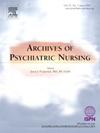Antipsychotic medication non-adherence and its associated factors among patients with schizophrenia in Ethiopia: A cross-sectional study
IF 2.2
4区 医学
Q1 NURSING
引用次数: 0
Abstract
Objectives
This study aimed to assess antipsychotic medication non-adherence among patients with schizophrenia in Ethiopia, and to explore its associated factors based on the Multidimensional Adherence Model.
Methods
This study is a cross-sectional study using convenience sampling enrolled 406 schizophrenia patients from July 17 to August 25, 2023. Data collection included medication non-adherence, sociodemographic factors, patient-related factors, therapy-related factors, condition-related factors, and healthcare system-related factors. Medication non-adherence was measured via the Morisky Medication Adherence Scale. Social support was assessed using the Oslo-3 social support scale (OSSS-3), and medication attitudes were measured via the drug attitude inventory-10 (DAI-10). Logistic regression analyzed associations between these factors and medication non-adherence.
Results
The antipsychotic medication non-adherence rate among Ethiopian schizophrenia patients was 42.4 %, with significant associated factors including no formal education (AOR = 3.093, 95 %CI: 1.426–6.709, P = 0.004), impaired insight (poor insight: AOR = 3.151, 95 %CI: 1.765–5.624, P < 0.001; partial insight: AOR = 4.309, 95 %CI: 2.463–7.539, P < 0.001), perceived stigma because of schizophrenia (AOR = 1.904, 95 %CI: 1.201–3.016, P = 0.006), polypharmacy (AOR = 2.133, 95 %CI: 1.339–3.396, P = 0.001), disease duration <5 years (AOR = 2.313, 95 %CI: 1.361–3.932, P = 0.002), and current substance use (AOR = 2.007, 95 %CI: 1.266–3.181, P = 0.003).
Conclusion
In this research, the antipsychotic medication non-adherence was relatively high, and seven significant associated factors were identified. Future research should target these factors to develop more effective strategies to improve antipsychotic medication adherence among patients with schizophrenia in Ethiopia.
埃塞俄比亚精神分裂症患者抗精神病药物不依从性及其相关因素:一项横断面研究
目的本研究旨在评估埃塞俄比亚精神分裂症患者抗精神病药物依从性,并基于多维依从性模型探讨其相关因素。方法采用方便抽样的横断面研究方法,于2023年7月17日至8月25日共入组406例精神分裂症患者。数据收集包括药物依从性、社会人口因素、患者相关因素、治疗相关因素、病情相关因素和卫生保健系统相关因素。通过Morisky药物依从性量表测量药物非依从性。采用Oslo-3社会支持量表(OSSS-3)评估社会支持,采用药物态度量表-10 (DAI-10)测量用药态度。Logistic回归分析了这些因素与药物依从性之间的关系。结果埃塞俄比亚精神分裂症患者抗精神病药物不依从率为42.4%,与未接受正规教育(AOR = 3.093, 95% CI: 1.426 ~ 6.709, P = 0.004)、洞察力受损(洞察力差:AOR = 3.151, 95% CI: 1.765 ~ 5.624, P <;0.001;部分洞察力:AOR = 4.309, 95% CI: 2.463-7.539, P <;0.001)、因精神分裂症而产生的耻耻感(AOR = 1.904, 95% CI: 1.201-3.016, P = 0.006)、多药(AOR = 2.133, 95% CI: 1.339-3.396, P = 0.001)、病程及5年(AOR = 2.313, 95% CI: 1.361-3.932, P = 0.002)和当前药物使用(AOR = 2.007, 95% CI: 1.266-3.181, P = 0.003)。结论本研究患者抗精神病药物依从性较高,存在7个显著相关因素。未来的研究应针对这些因素制定更有效的策略,以提高埃塞俄比亚精神分裂症患者的抗精神病药物依从性。
本文章由计算机程序翻译,如有差异,请以英文原文为准。
求助全文
约1分钟内获得全文
求助全文
来源期刊
CiteScore
3.70
自引率
0.00%
发文量
131
审稿时长
160 days
期刊介绍:
Archives of Psychiatric Nursing disseminates original, peer-reviewed research that is of interest to psychiatric and mental health care nurses. The field is considered in its broadest perspective, including theory, practice and research applications related to all ages, special populations, settings, and interdisciplinary collaborations in both the public and private sectors. Through critical study, expositions, and review of practice, Archives of Psychiatric Nursing is a medium for clinical scholarship to provide theoretical linkages among diverse areas of practice.

 求助内容:
求助内容: 应助结果提醒方式:
应助结果提醒方式:


